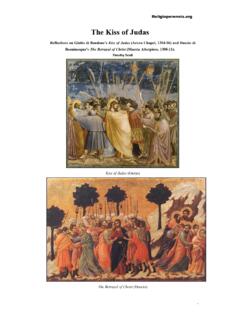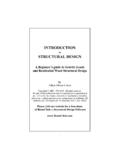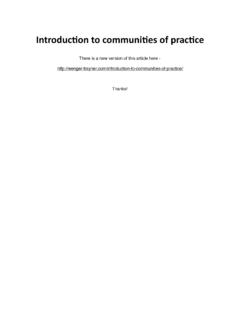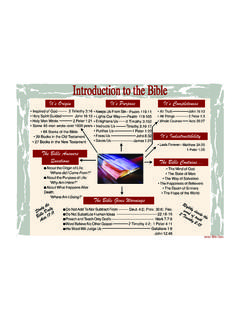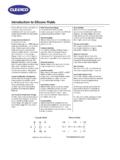Transcription of Introduction to the Perennialist School
1 To the Perennialist SchoolRenaud FabbriRen Gu non (1886-1951), Ananda Coomaraswamy (1877-1947) and Frithjof Schuon(1907-1998) are the main figures of the Perennialist School , a School of thought that, at thebeginning of the twentieth century, has developed a radical criticism of modernity on the basis oftraditional metaphysics (such as Sufism, Platonism or Advaita Vedanta). The Perennialist School ,not synonymous in every respect with the Traditionalist School , has given its contemporaryexpression to the Sophia Perennis or Perennial , tradition and Primordial TraditionRejecting the idea of progress and the enlightenment paradigm, Perennialist authorsdescribe modern civilization as a pseudo and decadent civilization, which manifests the lowestpossibilities of the Kali Yuga (the Dark Age of the Hindu cosmology). To the modern error, thePerennialists oppose an everlasting wisdom of divine origin, a Primordial Tradition , transmittedfrom the very origin of humanity and partially restored by each genuine founder of a new have a very specific definition of Tradition.
2 Tradition implies the idea of atransmission (tradere), but for Gu non and his followers, tradition does not have a human originand may be considered as principles revealed from Heaven and binding man to his divine the diversity of religious forms, they discern a single Tradition (with a capital letter), whatSchuon called a transcendent unity . They claim that the historically separated traditions sharenot only the same divine origin but are based on the same metaphysical principles, sometimescalled philosophia far as can be discovered, the term philosophia perennis is modern, first appearing inthe Renaissance. Though the term philosophia perennis is widely associated with thephilosopher Leibniz who himself owes it from the sixteenth century theologian AugustinusSteuchius. But the ideal of such a philosophy is much older and one could easily recognize it inthe Golden Chain (seira) of Neoplatonism, in the Patristic Lex primordialis, in the Islamic Din al-Fitra or even in the Hindu Sanathana Rediscovery of the Sophia Perennis in the writings of Ren Gu nonThe French author, Ren Gu non (1886-1951) was in a certain sense a pioneer in therediscovery of this Philosophia Perennis or better Sophia Perennis in the 20th century.
3 His viewlargely shared with later Perennialist authorities, is that Semitic religions have an Exoterism, the outward dimension of religion, is constituted by religious rites and amoral but also a dogmatic theology. The exoteric point of view is characterized by its sentimentalist , rather than purely intellectual nature and remains fairly limited. Based on thedoctrine of creation and the subsequent duality between God and creation, exoterism does notoffer means to transcend the limitations of the human state. The goal is only religious salvationthat Gu non defines as a perpetual state of beatitude in a celestial Gu non s view, esoterism is more than the complement of exoterism, the spirit asopposed to the letter, the kernel with respect to the shell. Esoterism has at least de jure, a totalautonomy with respect to religion for its innermost substance is the Primordial Tradition on pure metaphysics -by which Gu non means a supra-rational knowledge of the Divine, agnosis, and not a rationalist system or theological dogma- its goal is the realization of the superiorstates of being and finally the union between the individual self and the Principle.
4 Gu non callsthis union the Supreme Identity .By Principle, Gu non means more than the personal God of exoteric theology: the supra-personal Essence, the Beyond-Being, the Absolute both totally transcendent and immanent to themanifestation. In Gu non s view the innermost essence of the individual being is non-differentfrom the Absolute itself. Gu non refers here to the Vedantic concepts of Brahman (Principle),Atma (Self) and Moksa (Deliverance). This reference is not accidental or circumstantial. ForGu non, the Hindu Sanathana Dharma represents in fact the more direct heritage of thePrimordial Tradition . More generally, the great traditions of Asia (Advaita Vedanta, Taoism andMahayana Buddhism) play a paradigmatic function in his writings. He considers them as the morerigorous expression of pure metaphysics, this supra-formal and universal wisdom beingnevertheless in itself neither eastern nor to the Semitic religions, those Asian religions don t have an esoterism/exoterismstructure which has emerged only later in the historical cycle, at a time of growing spiritualdecadence, where the vast majority of the people were no longer qualified to understandmetaphysical truths and transcendent possibilities of the human state.
5 For Gu non, the author ofthe Crisis of the Modern World, the end of this descending process is modernity itself. Thetragedy of the Western world since the Renaissance is, in his view, that it has lost almost anycontact with the Sophia Perennis. Consequently, in the Western context, it is virtually impossiblefor a spiritual seeker to receive a valid initiation and to follow an esoteric , he has pleaded in his first books for a restoration of traditional intellectualit inthe West on the basis of Roman Catholicism and Freemasonry, it is clear that Gu non, very earlyon, gave up the idea of a spiritual resurrection of the West on a purely Christian basis. Havingdenounced the lure of Theosophism and neo-occultism, two influential movements that wereflourishing in his lifetime, Gu non was initiated in 1912 in the Shadhili order and moved to Cairoin 1930 where he spent the rest of his life as a Sufi Muslim. To his many corresponds, he Sufism as the more accessible form of traditional initiation for Westerns eager to findwhat does not exist any more in the West: a initiatory path of knowledge (Jnana or Gnosis),comparable to Schuon and the Religio PerennisFrithjof Schuon (1907-1998), one generation younger than Gu non, was among his earlyreaders.
6 Having read in his youth the Bhagavad-Gita, the Koran and the Plato, Schuon acceptedimmediately Gu non s criticism of modernity and defense of the Tradition and became one of hiscollaborators in Gu non s journal Les Etudes Traditionnelles. Schuon will nevertheless criticizelater in time some aspects of Gu non s exposition, particularly his Manichean opposition betweenEast and West and his theories on early Gu non s death in 1951, Schuon, in more than twenty books, has developed hisown metaphysical perspective, developing the concept of Religio Perennis, he considers lessambiguous than Gu non s Primordial Tradition. Schuon s Religio Perennis cannot be called anew religion with its own dogma and practices. For Schuon, the Religio Perennis is the underlying Religion, the Religion of the Heart or the Religio Concordis. He claims thatEsoterists in every orthodox tradition have a more or less direct access to it but, according to hisperspective, it cannot be a question of practicing the Religio Perennis independently.
7 Religiousforms can be more or less transparent but religious diversity is not denied for its raison d tre ismetaphysically explained. On the one hand, for Schuon, formal religions are upaya ( celestialstrategy ), superimpositions on the core-essence of the Religio Perennis. On the other hand,religious forms correspond to as many archetypes in the divine Word itself. Religious forms are willed by God and each religion corresponds to a particular and homogenous cosmos,characterized by its own perspective on the Perennialist perspective itself, as it has been expressed in its definitive form bySchuon, can thus been characterized as essentially metaphysical, esoteric, primordial but alsotraditional. For Schuon, there is no spiritual path outside of a revealed religion, which providesspiritual seekers with a metaphysical doctrine and a spiritual method, but also with a spiritualenvironment of beauty and both Gu non and Coomaraswamy had almost exclusively a purely intellectualinfluence, Schuon was not only a genuine metaphysician but also a spiritual master.
8 Since 1932,when, moved by a desire to get in contact with Sufism, he spent several months in Mostaganem,he was the direct disciple of the Algerian Sufi Shaykh Ahmad Al-Alawi (1869 1934). He receivedthe Islamic name of Isa Nur Ad-Din, Jesus Light of Religion . Technically, the Sufi brotherhood(tariqa), Schuon has organized in the mid-1930 s in Europe with the approval of Shaykh s, the successor of the Shaykh Alawi, was a regular branch of the ShadhiliyyaDarqawiyya Alawiyya Western readers of Gu non but also born Muslims have found in this teachings, apractical application of and a complement to the doctrine exposed by Gu non but also anopportunity to escape religious exclusivism. Whereas, many Turuq in North Africa or the MiddleEast, particularly since the 19th century, remain very close to the exoteric and exclusivistmentality, Schuon s teachings were by contrast clearly oriented toward pure esoterism and itsmessage was to Schuon, this quintessential esoterism and the Religio Perennis itself arepersonified by the Virgin Mary.
9 He called her, following the Iranian Sufi Ruzebam Baqli, theMother of all the Prophets and the Prophecy and the Substance of the original Sainthood .Schuon himself considered that his teachings, although located in the frame of Islam and Sufism,were in a certain sense at the confluent of the great religious traditions of the world (Islam,Christianity, Hinduism primarily but also Mahayana Buddhism, Neoplatonism and the NativeAmerican Traditions). In terms of spiritual discipline, it was centered on the Invocation of theDivine Name (dhikr, Japa-Yoga, prayer of the Heart), considered by him as the best andprovidential mean of realization at the end of the Kali or Perennialism?It could be argued that Traditionalism and Perennialism are synonymous, traditionalism being used mostly in France and Europe. However, Gu non himself dismissed the term oftraditionalist because it implies in his view a kind of sentimental attachment to a tradition which,most of the time, has lost its metaphysical another level, Perennialist School refers more specifically to Frithjof Schuon and hislegacy (Titus Burckhardt, Martin Lings, Seyyed Hossein Nasr), rather than Ren Gu non orAnanda Coomaraswamy.
10 Whereas for most French intellectuals, Gu non remains the centralfigure of the School , in the rest of Europe and in the US, Frithjof Schuon is regarded as the authorwho has given to the Perennialist message its definitive synthesis in the 20th century. His teachingis clearly more subtle and less Manichean than Gu non s who was also very much influenced byneo-occultism and a 19th century romantic view of the East. Schuon s teaching also clearlyincludes dimensions such as art and moral philosophy that were never addressed by Gu s perspective is also less academic and more directly oriented toward the spiritual lifethan Ananda Coomaraswamy s. Schuon, as the disciple of the Shaykh Alawi was also the only ofthese tree figures to have assumed an initiatory , Tradition is only one aspect of Schuon s teaching. More objectively than Gu non,Schuon acknowledges the contradictions between pure metaphysics -based on the intellect nature of things- and Tradition that he described, unlike Gu non, not a pure Good but as alesser Evola and the Perennialist SchoolIt is also important to make the following remark.
